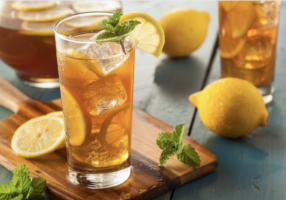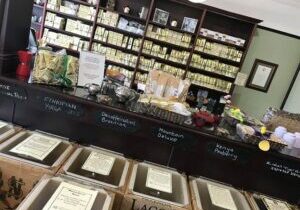I landed at Jorge Chavez International Airport in Lima at 7:30pm on 9th August and then took the 50-minute drive from Callao to Miraflores, without my luggage, which due to an error at Manchester was still in Manchester! However due to the miracles of modern technology I had a WhatsApp message about it the minute I stepped off the plane with the promise that it would be joining me in 24 hours. Happily, I had allowed myself 24 hours in Lima to get some sleep and catch up on work emails.
The official start of my trip was back at Chavez airport at 7:30am 11th August. So, due to the bad traffic throughout Lima I arranged for the taxi to arrive at 6am and found myself at the airport at 7:15am to meet the group that I would be travelling with. Once the introductions had been made, checking in, making our way through security etc we jumped on our plane and flew from Lima to Tarapoto which was a 2-hour flight away. The temperature increased significantly from 15 degrees C back in Lima to 33 degrees C on arrival in Tarapoto, which was most welcome!

Having disembarked and collected our luggage we were introduced to the Toyota minibus that we would be travelling in for the next three days. Our driver skilfully loaded our luggage onto the roof and secured with tarpaulin and a net and the 12 of us left for Juanjui, a 5-hour drive. During which the quality of the road varied from brand new metalled dual carriageways to rutted dirt tracks. We then had a little break in Juanjui and then took another 5-hour drive to Tocache where upon arrival, too tired for dinner we retired to our local hotel. If ever I’m staying rurally whilst traveling, I always make sure that I’m early in the morning to make sure I have hot water for a shower. However, the hotel we were in appeared to have no hot water at all so after a very brisk cold shower and a simple breakfast of eggs, plantains and corn cakes we left to visit our first producers, Oeko Co-operative.

The journey was undertaken in three Toyota Hilux trucks as we were going to be travelling not only off-road but also negotiating river crossings. The river crossing was interesting as the ‘ferry’ consisted of three empty boat hulls with thick wooden planks laid onto them and a corrugated iron roof sun-shelter. Our three trucks drove on, with the rest of the group walking on and the crossing commenced. The boats were steered by two small Yamaha outboard motors which were scarcely able to cope with the current. I was told that only 5 years ago we would have been in great danger in this area as at that time it was principally producing coca.

Upon arrival at Oeko we were greeted warmly, given coffee and our tour of the farm and its operations commenced. Happily, harvest was underway, and we were able to see the cacaoteros (cocoa famers) at work during their busiest time of the year. Many barrowloads of cocoa pods of various varieties, but all Fino De Aroma were being harvested. We cut open a few pods and were able to sample the delicious sweet pulp (pulpa) that covers the beans inside the pod. Different varieties of cocoa have slightly different flavours to the pulp, but all are sweet and very pleasant tasting. The only drawback is that the sweetness attracts insects so if you get any on your hands or face you will be covered in bites literally in seconds! We were then taken to see the area where the fermentation of the cocoa beans themselves take place. 
Fermentation is a very important part of cocoa production and it takes skill and experience to be able to ferment at the correct level. The actual process itself is simple enough; put the beans into clean wooden boxes, cover them and allow the bacteria in the air and the pulp on the cocoa beans to start the fermentation. It’s important at various times during the fermentation process to move the cocoa beans around using wooden, plastic or metal paddles. Bizarrely the smell of fermenting cocoa beans has a vinegary undertone due to the lactic and acetic acid bacteria. These microbes cause the temperature to rise to above 37 degrees at which point the temperature kills the beans and also contributes towards the flavour of the finished cocoa.

Saying goodbye to our kind hosts and hopping back into the trucks we made the river crossing again. We travelled for about 40 minutes to a place called Huánuco to visit an organisation called Central Cacao de Aroma. The co-operative had obviously anticipated our visit and we were surprised and very honoured to find quite a number of the co-operative farmers, had arrived to welcome us and talk to us about the cocoa they produce. The President of the co-operative addressed us in Spanish for about 10 minutes. Although my Spanish isn’t fluent, I was able to understand what was said and was also assisted by the lovely Joanna Meza from PromPerú (the organisers of the trip) who was able to fill in the gaps in my vocabulary. There is much respect due to these farmers who with the help of the Peruvian government and military stood up to the Cocaine terrorists and helped contribute to further reducing the cultivation and production of cocaine in Peru. The main reason these remarkable people gave for putting their lives at risk to do this was that they no longer wanted to live in fear of the terrorists.

Afterwards we were shown more fermentation and sun drying. Once the beans have been dried, sorting is critical, and we were proudly shown the brand new mechanical vibratory sorter. We were then taken back outside where we were served delicious fresh local fruits dipped in melted chocolate that had been produced from cocoa from the co-operative. The visit to Central Cacao de Aroma was an experience that I will never forget and my respect and admiration for these producers is huge.
Leaving Huánuco, we were in for a very, very long drive on mainly unmetalled roads but this time not in the trucks but in a minibus with all our luggage on the top. The drive was about four hours and we were all tired but exhilarated from our days experience. After a couple of hours, the bouncing and shaking had almost blended into the background when suddenly we stopped and could hear the driver quietly cursing. The reason for our stop was 40 tonnes of stuck cement lorry, which at a sharp dip in the road had become bogged down and was stopping the traffic from passing in both directions. We were determined that we were actually going to get to our destination so after 5 minutes pontification we decided that if enough people were to climb onto the trailer where it was attached to the truck and bounced, that we may be able to help the driver gain enough traction to get him moving again. Imagine the sight of 15 people standing on the front of the trailer and bouncing! This work very effectively and after two tries, we soon got the lorry moving again. We returned to our mini-bus rather dusty and dirty but full of laughter, enthusiasm and camaraderie. Needless to say, we were very pleased when we finally arrived at our local hotel back in Juanjui.
The following morning, I managed my first hot shower of the trip which was luxury beyond all luxuries. After breakfast we loaded the minibus ready for next day’s adventures, which started with a producer and processor of cocoa and native fruits called ‘ Wild Peru’. ‘Wild Peru’ are particularly interesting as thy are part of a larger organisation that operates in the UK called Sierra Organic with whom, I have several dealings and it was a pleasure to meet Joseph the English Director of the Peruvian processing operation. Anyone who knows me will know that I am fascinated by machines and things that go ‘whirr’ and ‘clang’ so imagine my delight when I saw that Joseph was overseeing the installation of a brand new 6 tonne cocoa press which had been imported from Italy. I have never seen a cocoa press before and so I got busy with my camera and took lots of photos as well as chatting to some of the engineers in my terrible Spanish, who were installing it. It was a pleasure to see Wild Peru / Sierra Organics operations and I am certain that over the next few months our relationship will develop further to become a good sustainable trading relationship.

After leaving ‘Wild Peru’ we drove for 20 minutes to the centre of Juanjui where we visited the headquarters of a large co-operative called Acopagro who have 2000 members in and around Juanjui alone. The total organisation consists of some 25,000 individual farming families with approximately 15,000 of those producing cocoa. In a short but very informative presentation not only did they explain the structure of this huge co-op but also went into some detail on the social projects upon which they spend the extra money that they earn from selling their products under Fairtrade standards. Amongst these projects are community kitchens, education (building schools and running social education projects), child nutrition, ophthalmological, and environmental campaigns to help preserve the rainforest and to assist in the sympathetic propagation of the products that are grown by the co-operative.
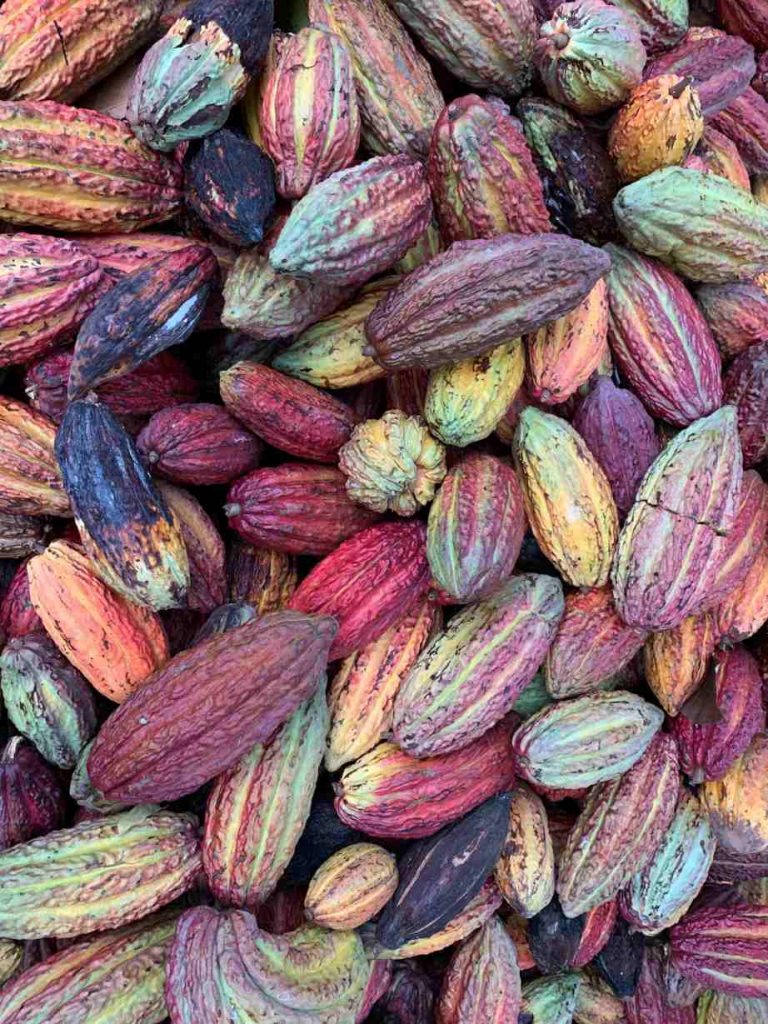
After we left Acopagro a drive of about 45 minutes had us comfortably out of Juanjui and into the countryside, where we were lucky enough to visit Maria, one of the members of Devida Co-operative. Maria has been growing cocoa with her family for 30 years and is one of the most experienced cocoa cultivators that I have met. Her green fingeredness and experience of growing Theobroma Cacao is renowned in the local area and the whole group was rather in awe of her husbandry and the passion with which she explained her work. We then drove from Maria’s farm back to Tarapoto as we had a flight the following day and sunk into our beds marvelling at what we had seen on yet another remarkable and engrossing day.
After a 7am breakfast our first visit of the day was to Amazona Cacao. Amazona Cacao produce some of the finest original variety chocolates and cocoa beans in Peru. They have won Great Taste Awards, trophies at Salon de Chocolat and Gold Awards at the Academy of Chocolate in America. Many members of our group were aware of Amazona and it was a pleasure to meet the head of the co-operative and his son who welcomed us with traditional local music, some of the freshest and sweetest fruits that I have ever eaten and an extremely interesting presentation on cocoa varieties, their pollination, cultivation and processing. Halfway through the presentation the heavens opened, as they only can in the Amazon. Happily, the rainfall only lasted about 30 minutes during which time we chatted with the two highly experienced owners of Finca Ecoperlacha.
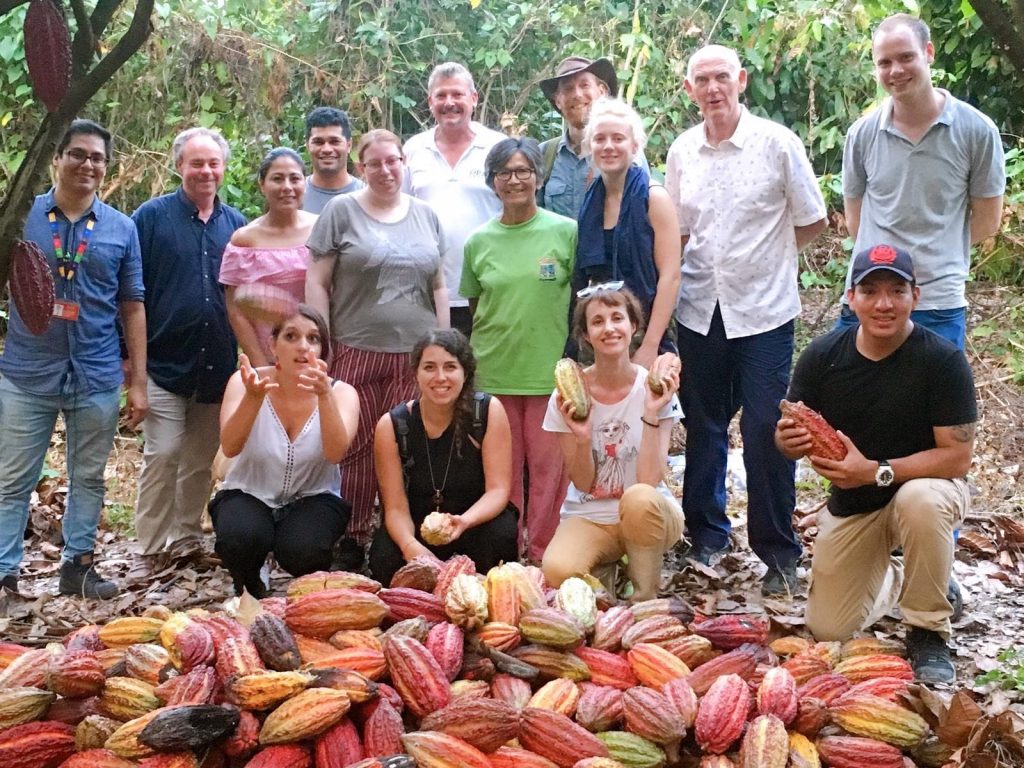
After the rain had stopped, we were invited on a tour of the local forest and also to see the effects of deforestation of the Amazon Rainforest. An area of forest next to the area that was owned by the farm was cleared by its owners for a housing project. The blackened stumps and exposed roots of clear area were a very stark contrast to the verdant lush rainforest in which Finca Ecoperlacha grow their cocoa. One of the biggest problems caused by the local deforestation had been the destruction of several colonies of golden ants whose main function in the forest is the pollination of cocoa bushes. This had caused the farm numerous problems but thankfully it had been noticed that a new colony of ants had started to build a huge nest within the boundaries of Finca Ecoperlacha.

After saying our goodbyes, we headed for our final visit to Instituto De Cultivos Tropicales, the foremost research centre on cocoa and other indigenous plants in Peru. Based on the regulations relating to Cadmium that were enforced in Europe from 1 January 2019 much of the group including myself had questions to ask about Cadmium uptake and transference on the multitude of varieties of cocoa that are grown in Peru to which we were given accurate and truthful technical answers. As a packer of cocoa powder for the multiples, their answers have been invaluable to me in helping to inform my customers. We were then given a tour around both the model plantation and the laboratories. Whilst touring the plantation we were also introduced to much of the flying and biting fauna that lives in the forest and in particular, the giant black ant.
We returned to our hotel for an early dinner and night as the following day we were flying to Iquitos, which is only accessible by boat or air for the famous Expo Amazonica in which the majority of the group including myself were participating in a series of pre-arranged business meetings with suppliers and producers of Peruvian agricultural products – in my case coffee and cocoa.

The following morning, we headed for the airport and three members of the group opted to take a Tuk-Tuk (a 3 wheeled 125cc taxi) and although a Tuk-Tuk can’t do more than 30mph they arrived at the airport a good 15mins before we did. After a short flight of about an hour we arrived in Iquitos, which is the town that had been elected to host Expo Amazonica for 2019.
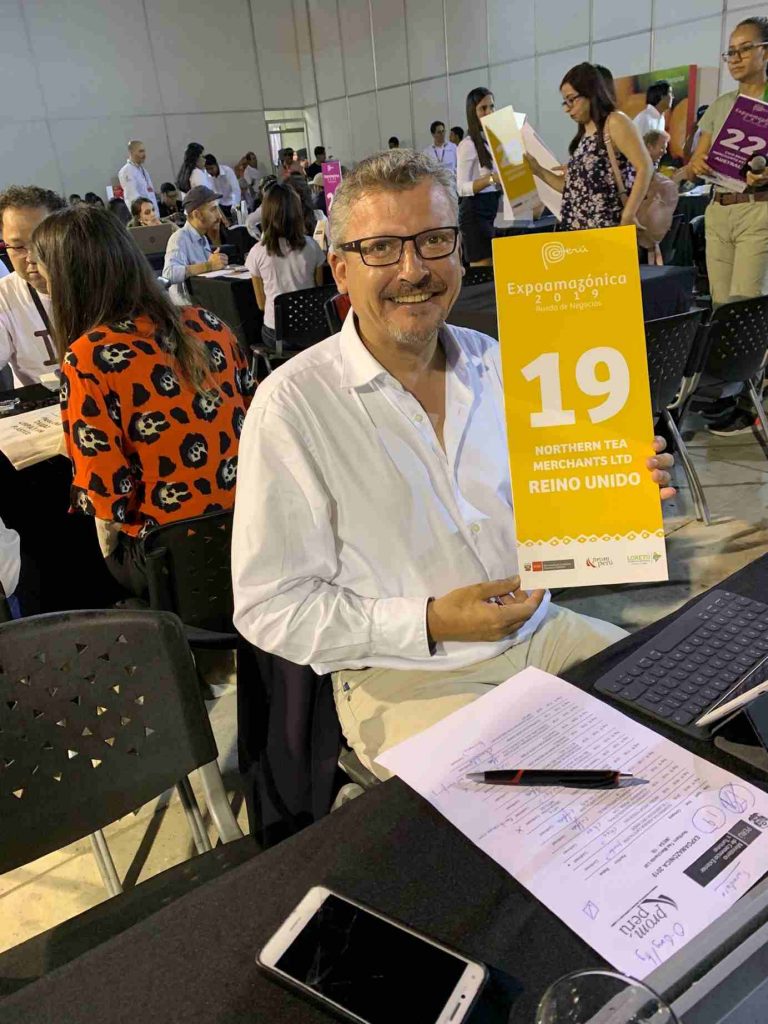
I was lucky enough to meet several very interesting potential new suppliers at Expo Amazonica, particularly of coffee and I have brought back some excellent quality samples to roast and import. After the meetings had finished, we had about an hour and half to have a proper look around the amazing event that is Expo Amazonica and I was introduced to several family members of one of our hosts, Mr Jaime Cardenas Perez. He introduced me to the ‘little baby’ of the family who was actually his brother who has approximately 2000 hectares of forest and farmland in which are planted many varieties of native fruits, and which supply his thriving national fruit juice business. By 6pm the show was winding down and we were ushered back to our coaches to return to our hotels where we were informed we had 30 minutes to get ready for a gala dinner that had been organised for the visiting politicians of Expo Amazonica and its guests.
The dinner was to take place in the middle of the Amazon on a huge pontoon that was only accessible by boat. The site of the illuminated pontoon and the smell of the food cooking in the kitchens wafted across the river and reminded me how hungry I was. The pontoon itself was bedecked with lights and banners and we were addressed by both the Minister for the Environment and the Minister for Agriculture before we sat down to eat.

The politicians in Peru are very involved in tropical agriculture as this is the mainstay of the majority of the rural population in Peru and the problems that they have had to deal with over the last few years are considerable. The gala dinner finished at about 10:30pm and a suggestion was made that we should experience a little of Iquitos’ nightlife and a live music salsa club which was about 5-minute walk from the Quayside was elected. I love live music and was not disappointed by the energy and passion with which the clubs incumbent band played their up-tempo Latin music. We returned to our hotel full of rum and hoarse voices from shouting at each other over the load music. Needless to say, getting up for breakfast the next morning was not an easy task, by 10am our coaches had arrived to take us back to Iquitos airport to make the return trip to Lima.

The next morning in Lima I took a few photographs of the city skyline which although were taken under Tupperware grey skies should give some idea of the sprawling metropolis that is home to 10 million Peruvians. The following morning (which was a Sunday) so happily the roads were almost deserted I took my final Peruvian taxi journey to Chavez airport to begin my 30 hours of travelling to get back to Chesterfield.
This was my third trip to Peru and is the one I would say upon which I learnt the most. The group with which I travelled contained artisans from several different cocoa disciplines and from whom I also learned a thing or too. If you get the chance to go to Peru, GO!




